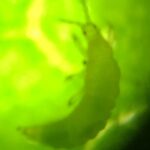Azamax & Azadirachtin
Grow Talk from Episode #50
The Dude: Azadirachtin, guys. Azamax, neem, all derived from neem, neem seed, and the neem tree. I love neem. I use a product called Azamax, which has the active ingredient azadirachtin.
Scotty Real: Neem has, what? Like, you know, a hundred compounds in it? Azadirachtin is one. Just like CO2 extract is one narrow column of extracts, that get you fucked up, that’s derived from cannabis and cannabis has three-hundred and sixty or whatever chemicals in it. That’s like what azadirachtin is to neem. Azadirachtin is the extract and neem is the whole plant I guess you would say.
The Dude: Azamax I like. It’s really easy to use. It dilutes out well in water at a decent range of temperatures where as neem is a little bit trickier.
Scotty Real: You can tell neem is like squeezed juices of the plant. You know what I mean? It’s got a different smell to it.
The Dude: It’s squeezed right out of the seed I believe.
Scotty Real: Yeah, I’ve actually grown neem trees and they’re really cool. You can rub the leaves on you for an insect repellant. It’s neat stuff.
The Dude: So the debate was – I used to soil drench with Azamax. Scotty went and found an article and we also had a listener chime in, right?
Scotty Real: Let me give him a shout out, that kid is intelligent as hell, man. I appreciate the hell out of that. I’m finding his name right now, man.
The Dude: So I’ll start off with the article we pulled up, it basically gets into it. In a nutshell…
Scotty Real: Josh! Shout out to Josh. Thank you for checking our work, brother.
The Dude: This is a scholarly article and there are many more on the internet, the kind of things you got to pay to see more of…but like, in a nutshell…
Scotty Real: Go to Google Scholar, you guys. If you really want to get the answers, man, type in Google Scholar. That brings you to a different level of Google and you’ll find a bunch of peer reviewed research. So a guy does a paper at the university level, he submits it to a bunch of people for peer review, and if they think it’s worthy than it stays up and it becomes a peer-reviewed paper, man. And that’s where you get real deal scientific facts on what happened during experiments.
The Dude: When I got information back in the day it was a rep. or somebody somewhere in the industry in the know, I was taught using Azamax. Azamax plays friendly with soil beneficials. That’s your bacteria, trichoderma, all the good shit, all your little beasties in the soil. This scholarly article contradicts that entirely and I saw some of the articles were from over in India where all this neem is like…that’s a thing. It’s a huge industry over there. There’s like neem world. We’ll go tour it sometime.
Scotty Real: University of the United States of India?
The Dude: Yes.
Scotty Real: I’ve heard of the place. Excellent place, man.
The Dude: Basically in all their trials they suppressed the bacteria for sure. They would say populations could recover…
Scotty Real: Yeah – after sixty days.
The Dude: Yeah, we’re talking recovery is like the whole cycle of our flowering. They’re looking at fields of trees and shit might have time to recover. We don’t have time for suppression at all on our soil life.
Scotty Real: I will tell you though, that’s why I say add a little bit of recharge all the time, with every watering. Because when you’re killing shit, you’re reintroducing it. Even if they’re dying they’re still in there for a while. You’re still introducing massive amounts.
The Dude: So you like to cut the rate in half and use a little bit more frequently? Something like that?
Scotty Real: I always cut it in half, and then double it, man. That’s my move.
The Dude: Gotcha. I like that. Cut it in half, then double it and water it in. But, man, it changed my mind for sure. It definitely said fungi as well. Those fungi’z were really suppressed by the use of azadirachtin or any type of drench.
Scotty Real: They weren’t that fun anymore when it happened.
The Dude: They weren’t that fun anymore.
So I called up GH (General Hydroponics) just trying to get some info and they were kind of – precautionary, I’ll say – they gave me the phone number of the parent company that makes Azamax. GH I guess is kind of the quality control/distributor or something, I would say. Love the product for spraying the leaves and everything. I used to like it as a drench. I was doing a maintenance drench. Now don’t get me wrong, if I’m trying to attack something in the soil negatively, I’m going to take care of those pests before I worry about my soil life and then reinoculate after I get some control. But they didn’t really have an answer for me. Long story short.
Scotty Real: We sell it. Would you like to buy some?
The Dude: Well I told them straight up, “Well, I’m using your subculture ‘M’ and ‘B’”, or something. They’re biological products. I’m not using that but I wanted to start the conversation, “…As you have three products here, one’s more mycorrhizae and one’s more bacteria, and then can I drench in my Azamax?” And the answer was yes. So that’s when I started with – “Well, I don’t know. I’ve been reading things on the Internet and…” She just kind of steered me to call the company and see if they had done any studies on that. So regardless, as just like an update, I used to advocate it but I don’t anymore. I’m not going to be drenching Azamax in my soil, definitely will be using it above canopy, and actually I’ll give a quick tip – any of you guys out there who were going to get that transport from Optic Foliar, or anybody out there who wants to use it – use Azamax or neem like at half strength or less with that product. And then only spray the tops of your leaves, not the bottoms. So when you guys get that sample, check it out, try it out, I want to hear how that works out for you. Worked out good for me, so…
And you’re using a great product. Otherwise if you guys don’t know anything about neem or azadirachtin it’s pretty good shit. I’ve used it for a long time. It seems like the industry is pretty Earth-friendly and there’s a good thing going on with the products. It combats a lot of stuff; I swear the plants like it.
Scotty Real: Yeah. I like it. I’ve had friends that use that as their IPM. They’ll do a once a week foliar of neem. It does mix well with other stuff. Dr. J[ohn] was saying he puts a little bit – and neem is cheap – neem is like twenty bucks or something like that for eight or twelve ounces of it. Now, the azadirachtin, that shit is really expensive. I guess it’s like a bitch to get that extract or I guess you got to start with expensive neem oil…
The Dude: Yeah, it’s concentrated. But it worked. And like you said you can use azadirachtin concentrates such as Azamax in a fogger pretty well. I’m not sure how well you can use straight neem in a fogger. You might have some good cleaning to do.
Scotty Real: It’s heavy. The neem oil looks like, you know, an oil. It’s probably got the same viscosity as vegetable oil. And it’s got a funky smell to it, too. You definitely don’t want to spray neem on flowers, man.
The Dude: You can use it up until week 3. I would use it up to week 3 and then after that I would cut it out. And if you guys are new growers out there and you don’t know much about it, like Scotty was saying, your easiest, most least expensive pest prevention program is some straight neem oil. Cut it – in fact, you don’t have to cut it with anything. Just put it in some warm water and spray it every seven to ten days up to your third week of flower and you should be almost problem free. You can get a little more sophisticated if you want. Add silica to it, use some transport. There’s a lot of kelp in there. But, off the bat if you want one thing that can handle most problems you’re going to get – neem oil. Just don’t wait until you get the problem.
So, what else you got? You got anything else on our featured product?
Scotty Real: Yeah, you know. If you’re using a bunch of microbes, man, I would not water Azamax or azadirachtin in, man, I’m over that.
The Dude: Yeah, I only would be doing that if – I mean the most common pest people battle is the root aphids where Azamax is on my low end of what’s going to take out those root aphids…
Scotty Real: It’s not going to help. If you got root aphids you got to use a beneficial. So, as a matter a fact now that I’m thinking about it I know people that are using Azamax and then they are putting in the beneficial bacteria, the BotaniGard from Bioworks, or the Met33, those are living bacterias that attack the root aphids. So now you’re killing that stuff with your Azamax. A lot of these people they sit there like, “Oh, I’m nukin’ ‘em, man, I got everything!”, and I’m like well you’re killing, you’re destroying each thing you did three days ago with the thing you do with the other nuke you put in. People go from, “I’m using imidaclorprid, and then three days later I used Azamax, and then three days later I used BotaniGard, “Oh man, I’m so on these things I’m hitting them with so much.” Yeah, the Azamax is killing the BotinaGard and the imidaclorprid is killing everything, man.







What ya all think???? Azamax and/or Neem uses in hydroponic/indoor garden areas. I damn sure love both growing outdoors!
As an added comment if and when I use neem or any type of oily compound I add a few drops of dawn dish soap it helps break down the oils so they adhere better to the foliage
I am on my very first round of no till indoor and I have been battling russet mites. Now I have discovered root aphids!! Please help. I can’t afford to start over. I think I killed my worms because I thought I had fungus gnats so I stopped watering for a few days and put a think layer of DE on top. So I just heard you say to use a beneficial. I hope I can find some locally. Thanks for all your shows. If you have any more advice for me I would greatly appreciate it. I have never been more stressed out over bugs.
Well Susan if you have russet mites and root aphids you’re fucked. Nothing you do other than kill your crop and start over at this point will work. The damage is done letting them in your garden. Sorry.